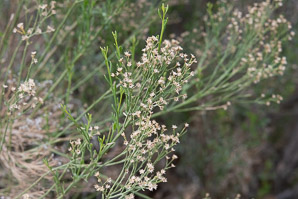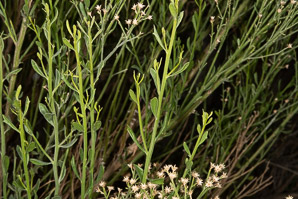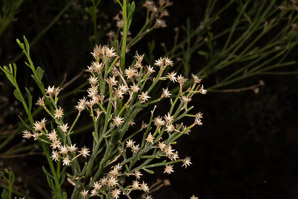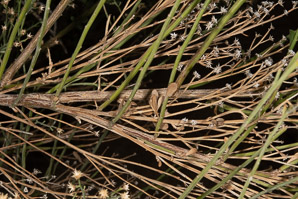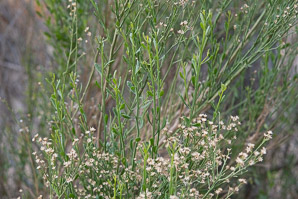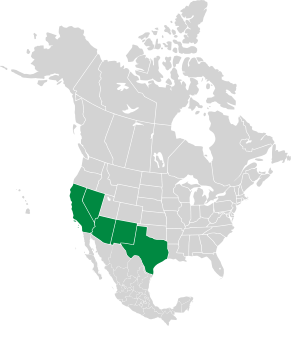
|
Baccharis sarothroides A. Gray Desertbroom, greasewood, rosin-bush, groundsel
Desertbroom’s name derives from the appearance of this shrub during the summer, when its already small leaves mostly drop off to minimize water loss. (Plants that drop leaves during the summer are drought deciduous.) The resulting brown woody bush looks like a broom, and was often used for this purpose. This species is native to the American southwest and northern Mexico, and favors washes, roadways, and other disturbed areas, and both wet and dry habitats, at elevations below a mile. There is a cultivar of this species that is prostrate instead of bushy in appearance, useful for ground cover. But the native version is considered invasive by some, and the cultivated form may revert to the native version. Plants: Rounded shrubs up to 13′ (4 m) high and 6′ (1.8 m) around, densely branched. Main stems are green and sharply angled, becoming brown and woody. Flower-bearing stems are green and almost leafless. Stems are resinous and very pungent. Leaves: Green, sessile (directly attached to the stems), thick, and narrow. They are linear to oblanceolate, less than 1¼″ (3.5 cm) long and 1/32-1/16″ (1-2 mm) wide, with a single main vein. Flowers: Abundant, rayless, puffy flowers are white to cream or tan. Plants are dioecious. Female plants produce slender showy flowers from August to November. Flowers on male plants are not showy. Fruits: Female flowers produce seeds borne on light fuzzy “parachutes” that fill the air. Medical: The Seri Indians made a decoction by cooking the twigs. This tea was used to treat colds, sinus headache, and as a rub for sore muscles. (Felger, R. S. and M. B. Moser, 1985, People of the Desert and Sea. University of Arizona Press, Tucson, AZ) Such decoctions were used also to treat coughs and stomach aches. However, this species is not listed in the Physician’s Desk Reference for Herbal Medicines, so it has no substantiated medical uses. Online References:
Southeastern Arizona Wildflowers and the Plants of the Sonoran Desert CalPhotos (photos) Chris A. Martin's site at Arizona State University SEINet—the Southwest Environmental Information Network
Baccharis sarothroides description by Thomas H. Kent, last updated 25 May 2020. © FloraFinder.org. All rights reserved. |
5/2/2018 · Cottonwood Spring, Joshua Tree National Park, California · ≈ 12 × 8″ (31 × 20 cm) 5/2/2018 · Cottonwood Spring, Joshua Tree National Park, California · ≈ 10 × 6″ (24 × 16 cm) 5/2/2018 · Cottonwood Spring, Joshua Tree National Park, California · ≈ 6 × 4″ (16 × 11 cm) 5/2/2018 · Cottonwood Spring, Joshua Tree National Park, California · ≈ 8 × 5″ (20 × 13 cm) 5/2/2018 · Cottonwood Spring, Joshua Tree National Park, California · ≈ 15 × 10″ (39 × 26 cm) Range:
|

